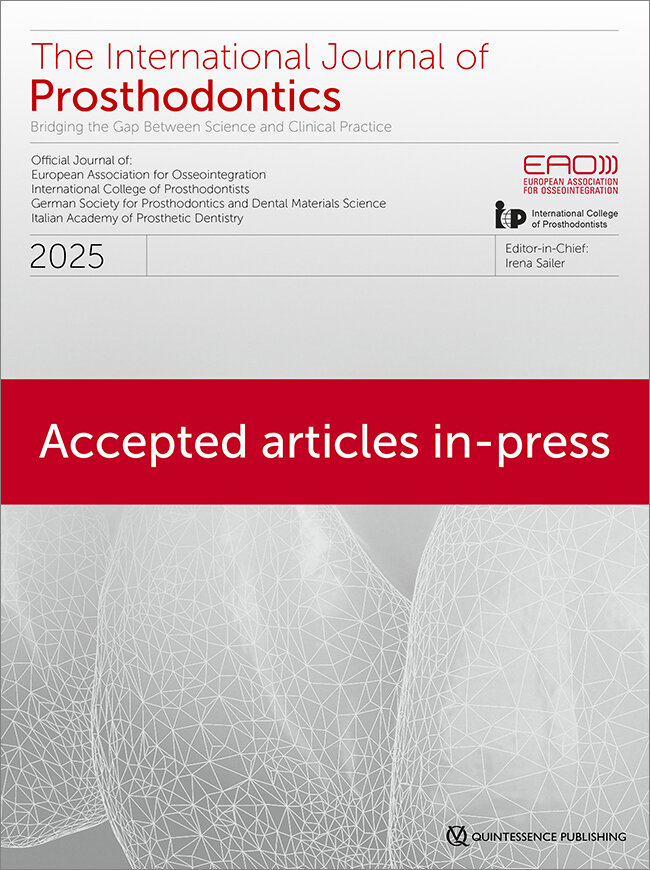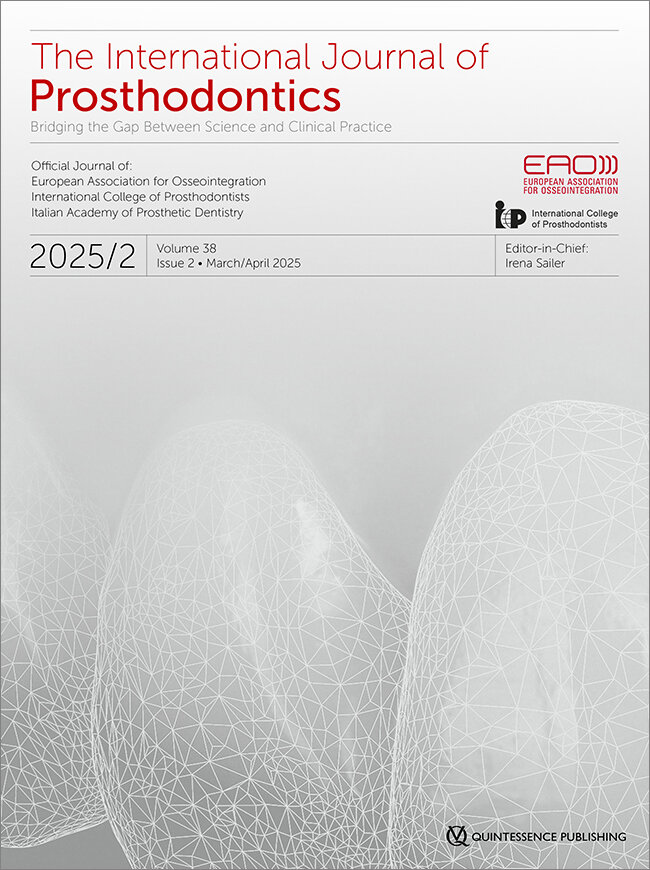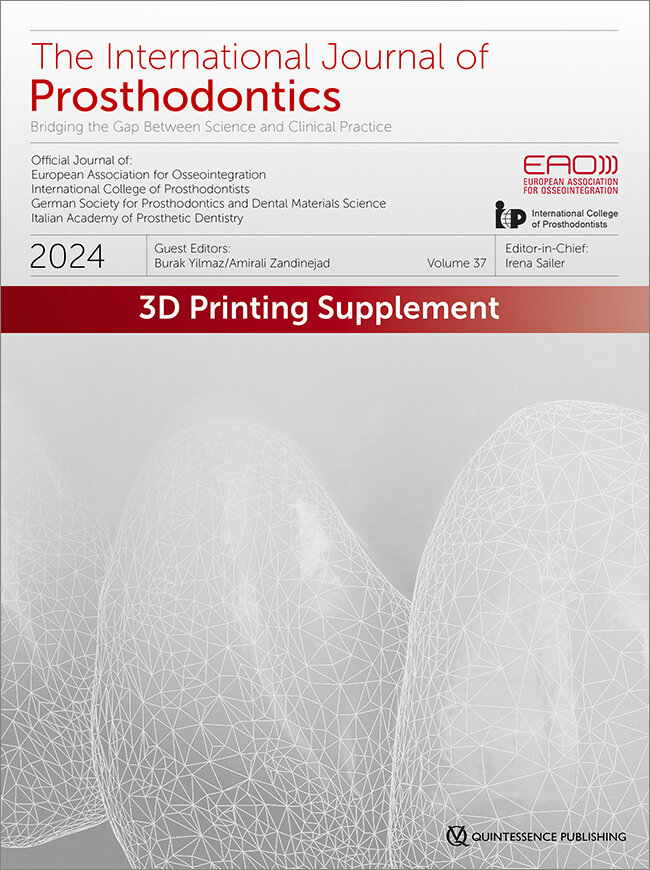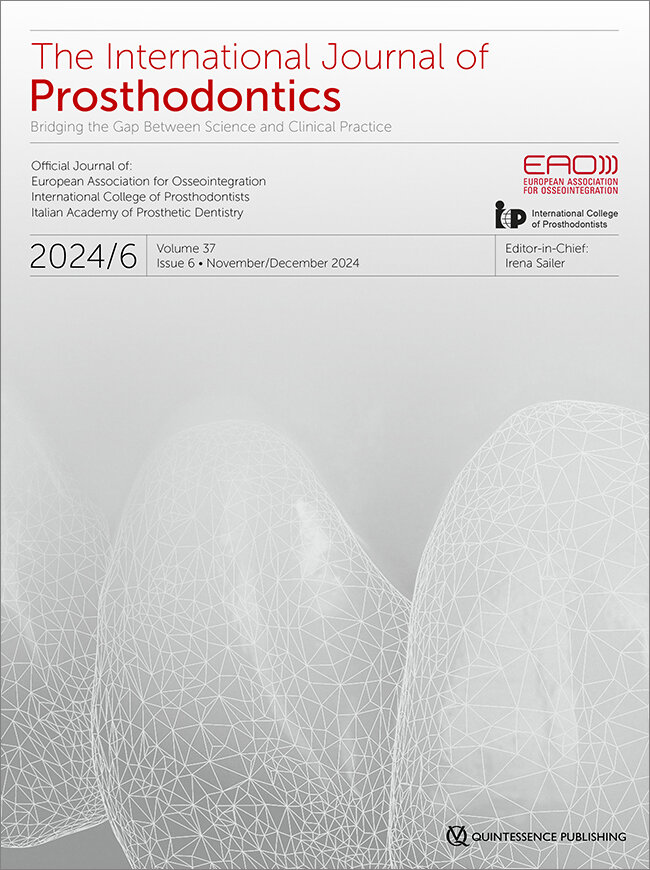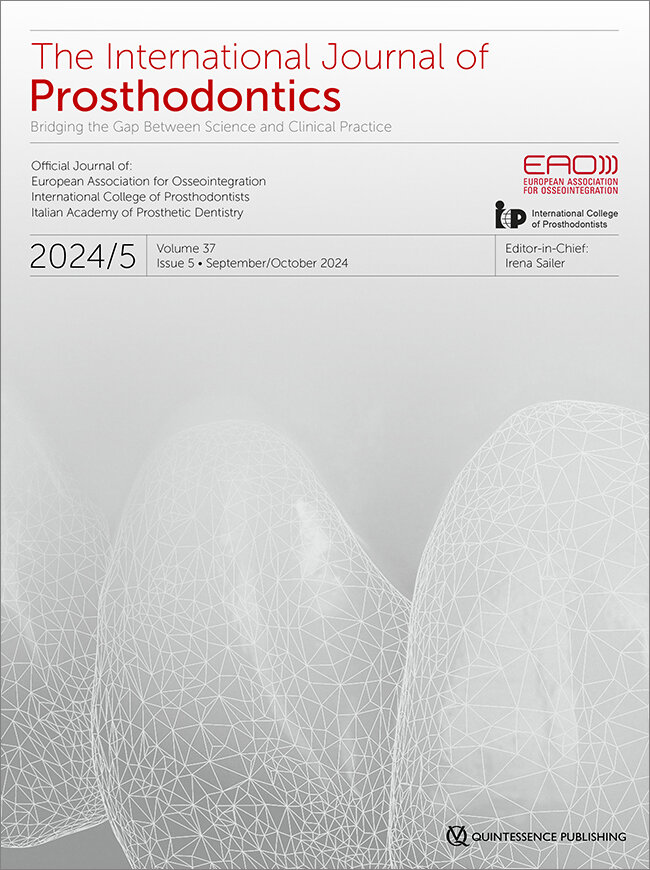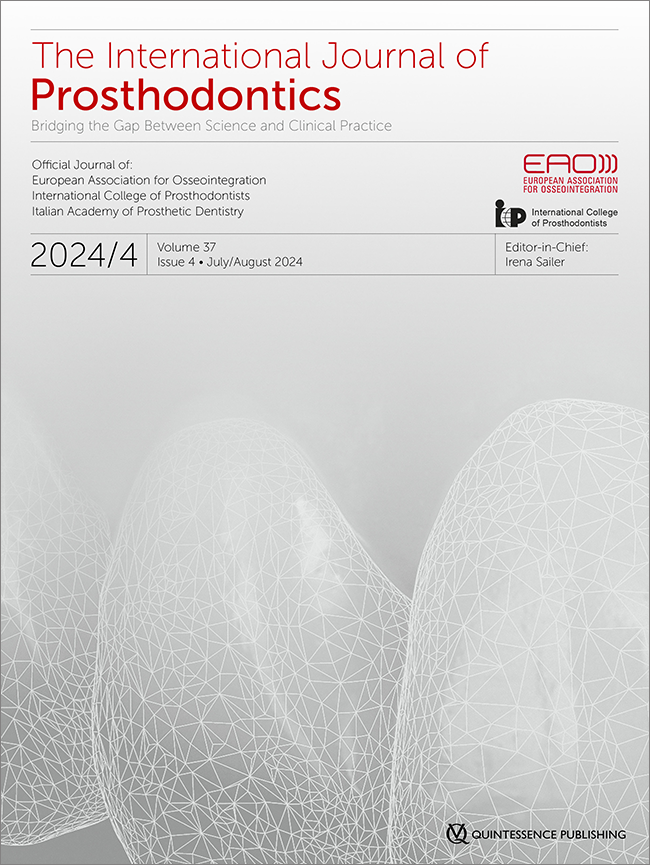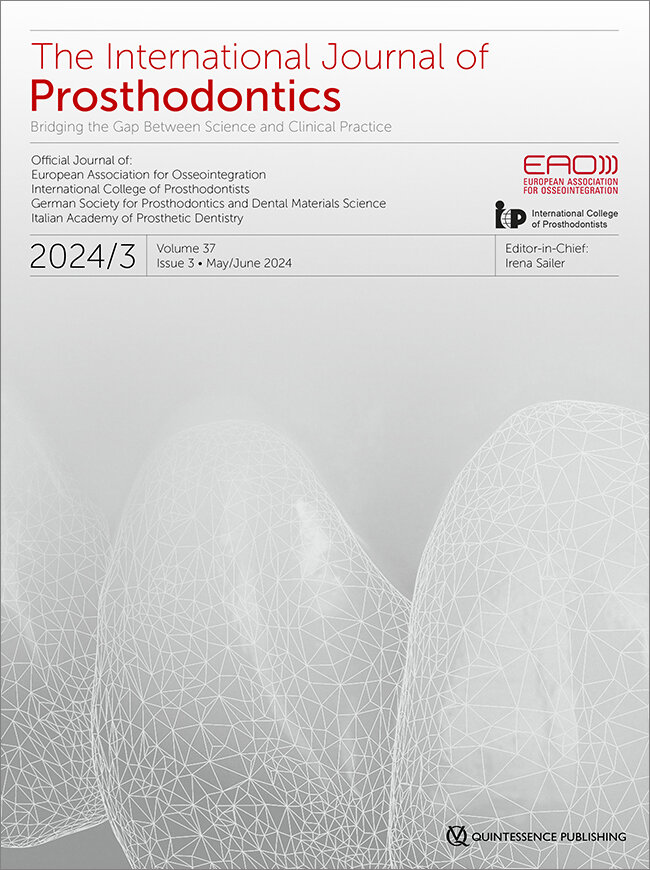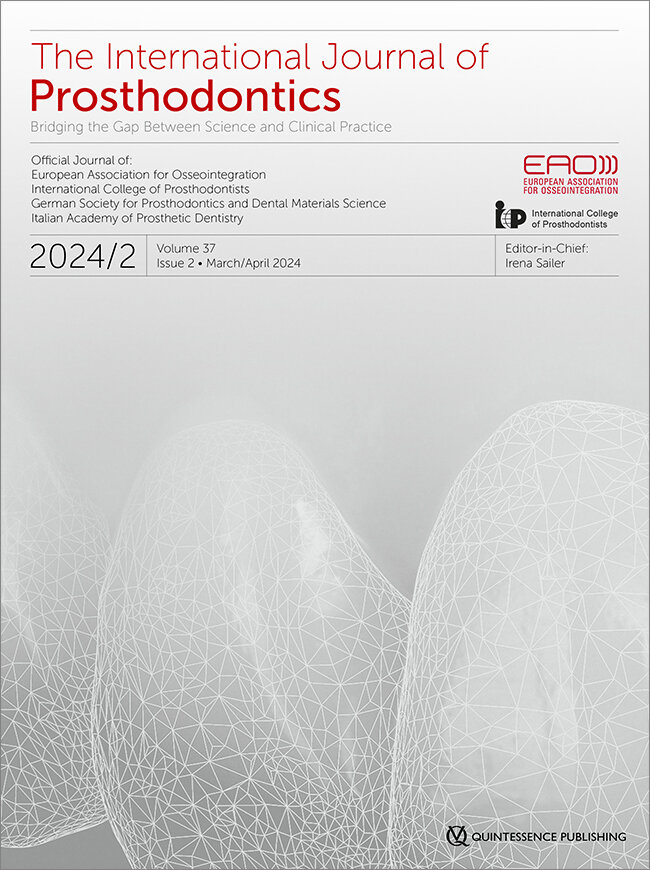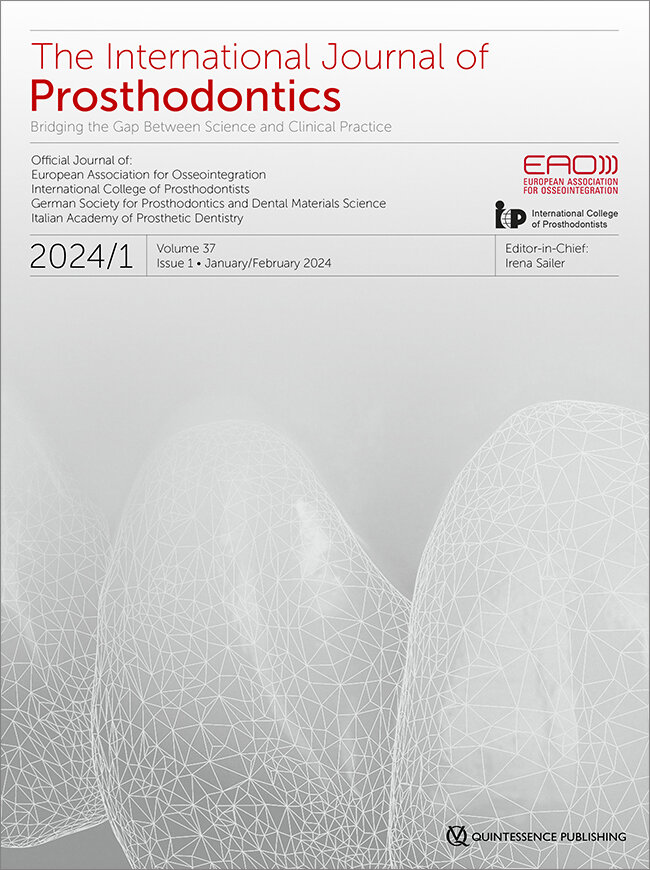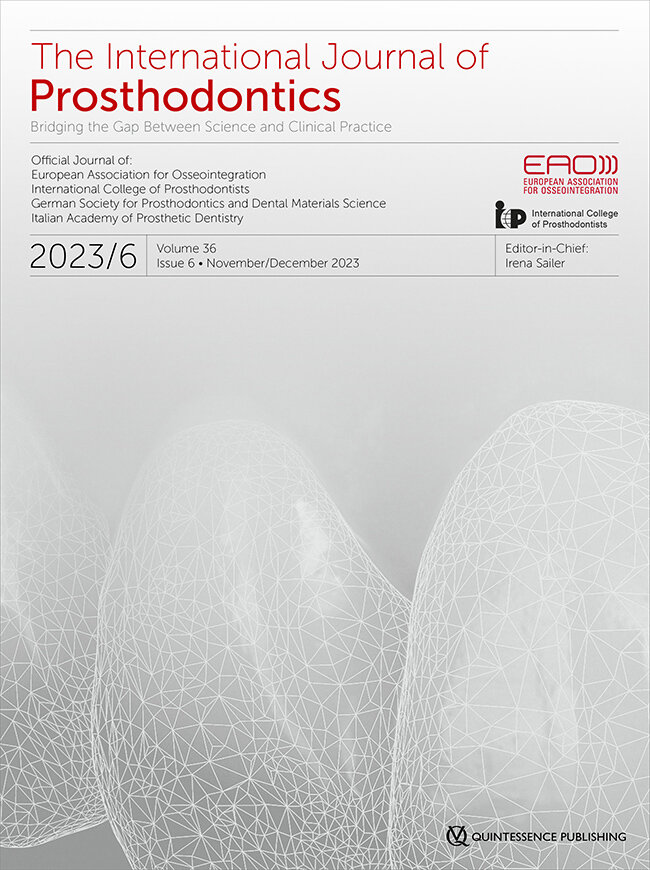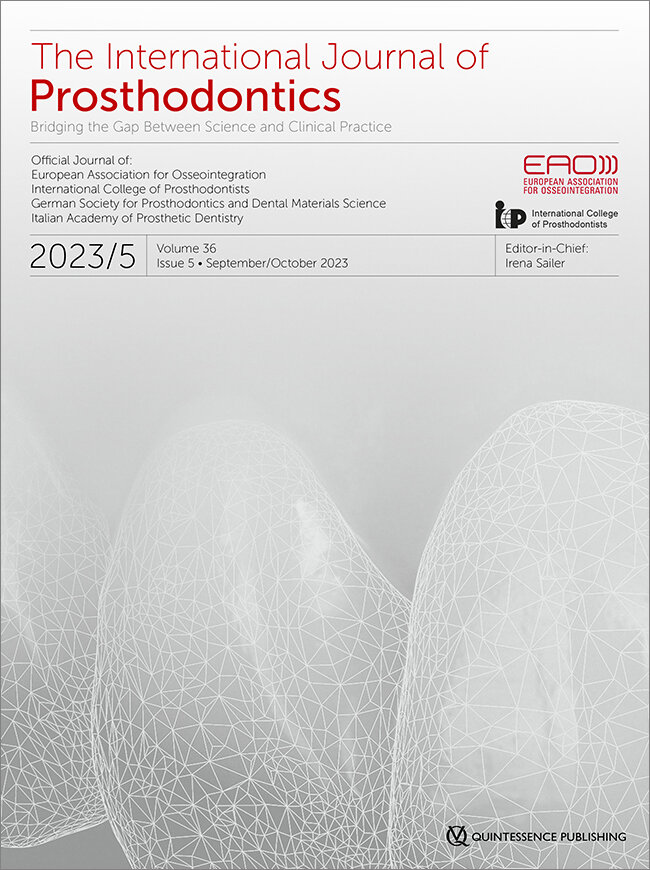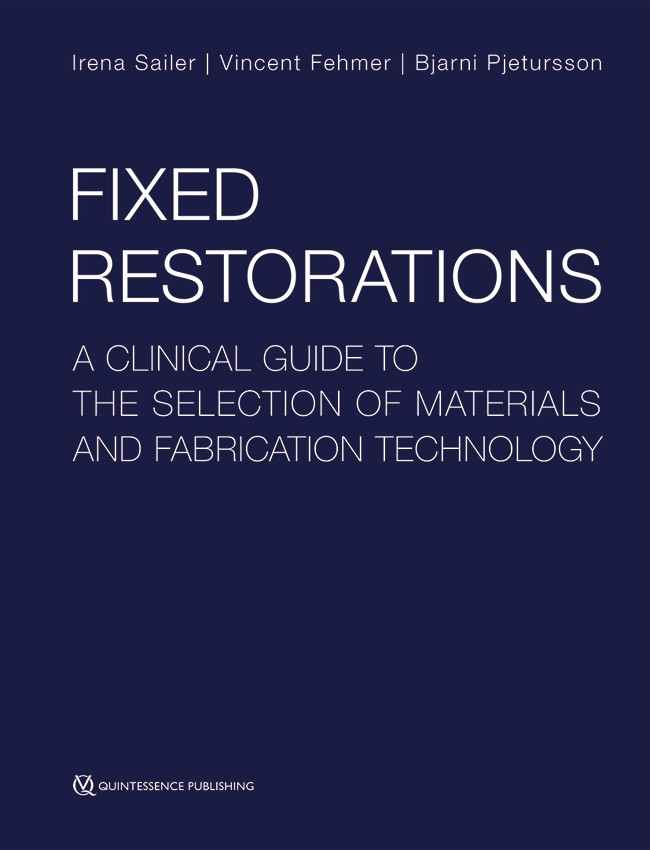DOI: 10.11607/ijp.2025.2e, ID de PubMed (PMID): 40112279Páginas 155-156, Idioma: InglésSailer, IrenaEditorial DOI: 10.11607/ijp.8849, ID de PubMed (PMID): 39466611Páginas 157-164, Idioma: InglésMazlan, Mohd Khairul Firdaus / Mahmud, Melati / Ahmad, Rohana / Lim, Tong WahPurpose: To compare the maximum occlusal force (MOF) in endodontically treated teeth (ETT) and their vital contralateral counterparts and to evaluate the intraoral factors affecting them. Materials and Methods: A total of 30 adult participants presenting with an endodontically treated tooth and its vital contralateral counterpart were recruited for this split-mouth study. MOFs were measured using a wireless sensor network occlusal force recorder, and the mean MOF of ETT was compared to that of their vital contralateral counterparts. Multiple-factor ANOVA was used to examine the association between various clinical factors and MOF. Results: The mean MOF for ETT was significantly higher than their vital counterparts (215.44 ± 74.11 N and 202.40 ± 70.67 N, respectively; P < .001). Among the clinical factors, the MOFs were significantly influenced by the location of teeth (P < .01) and the crown-root ratio (P = .01). Upon further analysis of ETT and control teeth, the location of teeth was identified as the sole factor associated with MOF, with P < .05. Conclusions: The MOFs for ETT were statistically significantly higher than those of their corresponding vital contralateral teeth.
DOI: 10.11607/ijp.8924, ID de PubMed (PMID): 39466615Páginas 165-174, Idioma: InglésMerli, Mauro / Aquilanti, Luca / Pagliaro, Umberto / Mariotti, Giorgia / Merli, Marco / Nieri, Michele / Rappelli, GiorgioPurpose: To evaluate the impact of a full digital workflow on the restoration of masticatory function and esthetic features in subjects rehabilitated with a fixed prosthesis. Materials and Methods: The study involved 12 adult participants in need of complex rehabilitation due to masticatory dysfunction. They underwent a comprehensive diagnostic examination involving intraoral scans, facial 3D-photos, jaw kinematics recording, and CBCT extended to the temporomandibular joint (TMJ). The subjects were consecutively treated with a fixed prosthesis following surgical and implant therapy using a full digital individualized workflow. Three different study moments were set: diagnostic phase (T0), 1 week after the delivery of the prototype (T1), and 1 week after the delivery of the final prosthetic solution (T2). Results: Jaw kinematics recording showed a widening of movements at T2 compared to T0. Sagittal movements increased by 5.7 ± 6.4 mm (95% CI from 1.7 to 9.8, P = .010), frontal movements increased by 7.2 ± 5.6 mm (95% CI from 3.6 to 10.8, P = .001), and horizontal movements increased by 1.7 ± 4.5 mm (95% CI from –1.1 to 4.6, P = .210). Occlusal adjustment timing at T1 was 350 ± 175 seconds, while at T2 it was 677 ± 286 seconds. At T2, functional visual analog scale (VAS) was 9.4 ± 0.4 while esthetic VAS was 9.3 ± 0.4. Conclusions: The rehabilitation process using the full digital workflow showed a widening of the sagittal and frontal masticatory movements with short occlusal adjustment time and with functional and esthetic satisfaction by all the subjects.
DOI: 10.11607/ijp.8972, ID de PubMed (PMID): 38758586Páginas 175-184, Idioma: InglésAmato, Francesco / Spedicato, Giorgio A.Purpose: To evaluate and compare the implant survival rate, marginal bone levels, and prosthesis failure rate of a three-unit fixed dental prosthesis (FDP) supported with three or two implants immediately loaded in the posterior area. Materials and Methods: Partially edentulous patients in need of a three-unit implant-supported FDP in the maxillary/mandibular posterior region were recruited and randomly split into two groups: a control group with three-unit FDPs supported by three implants (3I group), and a test group with three-unit FDPs supported by two implants (2I group). Implants were inserted and immediately loaded with a temporary FDP. Results: In total, 63 patients were included in the study. A total of 178 implants were placed and immediately loaded (128 maxillary and 50 mandibular) to support 74 immediate provisional fixed prostheses (52 maxillary and 22 mandibular) delivered on the same day of implant placement: 30 in 3I group and 44 in 2I group. The comparison of three vs two implants resulted in comparable implant survival rates, marginal bone loss (MBL), and prosthesis failure rates. All implants healed uneventfully with no adverse clinical and radiographic signs or symptoms except for one implant failure in the 3I group resulting in a cumulative success rate of 99.5%—98.9% for the 3I group and 100% for the 2I group—with a follow-up of 6 to 10 years (mean: 7 years). Once loaded, the implants remained in function from a minimum of 6 years to 10 years. Conclusions: Although more studies and larger sample sizes are needed to validate this study, the results showed no difference between the two groups, demonstrating the potential viability of both clinical options.
DOI: 10.11607/ijp.8757, ID de PubMed (PMID): 38466571Páginas 185-190, Idioma: InglésKheur, Mohit / Kalsekar, Shifa / Kheur, Supriya / Jung, Ronald E. / Lakha, TabrezPurpose: To evaluate the suitability of maxillary premolars for immediate implant placement (IIP). Based on prosthetically driven treatment planning, a simple classification system was developed. Materials and Methods: In total, 150 CBCTs of maxillary first premolars were analyzed in BlueskyBio software. The topographic position of the tooth was determined by analyzing the dimensions of the buccal and lingual cortical plates, the distance between the buccolingual plates, and the residual bone height from the root apex to the floor of the sinus. Virtual placement of an implant was carried out such that the implant would be positioned 1 mm apical to the buccal bone crest, would engage 3 mm of bone apical to the root apex, and would have a trajectory so that the abutment access was from the central fossa. Four categories were identified, and the classification was proposed. Results: It was observed that 74% of cases had buccal bone < 1 mm and 26% had buccal bone > 1 mm. It was also observed that 79% cases had an average distance > 3 mm between the root apex and maxillary sinus (with 21% of cases < 3 mm). The categorizations of implant placement were as follows: Type 1 (24%), Type 2 (56.6%), Type 3 (43.3%), and Type 4 (0%). Conclusions: In the majority of maxillary first premolars, IIP is possible with the implants to be placed in the palatal sockets or the furcation area. In cases where the buccal plate thickness is inadequate, simultaneous grafting should be considered between the implant and buccal plate.
DOI: 10.11607/ijp.8778, ID de PubMed (PMID): 38466570Páginas 191-195, Idioma: InglésMcSweeney, Jack / Bartlett, David W. / Varma, SachinPurpose: To determine the frequency of insert changes for combined maxillary and mandibular implant overdentures (IODs) using the Locator Legacy system and to assess the survival of dental implants with IODs. Materials and Methods: This retrospective audit reviewed clinical records with up to 12 years of follow-up from 785 patients who received IODs using the Locator system at a dental hospital. In total, 151 had a combined maxillary IOD opposed by a mandibular IOD and of those, 37 had data retrieved using a minimum data set. The frequency of insert change was recorded and descriptive analysis was provided by means and SDs for continuous variables. Frequencies of categorical values were reported as percentages. Results: In total, 222 implants were placed in 21 men and 16 women with a mean age of 67.5 years (SD 8.8). All patients were reviewed at least once. Maxillary and mandibular IODs experienced 1.9 (SD 2.0) and 1.2 (SD 1.2) mean insert changes per patient, respectively. The mean time (SD) between initial and first insert change for maxillary and mandibular IODs was 3.4 months (SD 3.2) and 6.4 months (SD 7.2) and between the first and second insert change was 9.9 months (SD 9.0) and 10.0 months (SD 8.3), respectively. Implant failure was 21.6% and 2.7% in the maxilla and mandible, respectively. Conclusions: Clinicians should anticipate the first insert change around 3 months for maxillary IODs and 6 months for mandibular IODs. Subsequently, the second insert change should be expected around 10 months for both maxillary and mandibular IODs.
DOI: 10.11607/ijp.8903, ID de PubMed (PMID): 38536147Páginas 196-205, Idioma: InglésAlshubrmi, Hasna / Mousa, Mohammed A. / Taher, Ibrahim A. / Sghaireen, Mohammed Ghazi / Ganji, Kiran Kumar / Issrani, Rakhi / Alzarea, Bader K.Purpose: To evaluate the adherence of three types of bacteria (Staphylococcus aureus, Escherichia coli, and Pseudomonas aeruginosa) and the size of the microgap of three different implant systems (JD Icon Plus [JD], ORA system [Ora; Dental Tech], and Ankylos [Dentsply Sirona]) under four different screw torque values. Materials and Methods: A total of 10 samples for each tested implant system were used under different torques to determine the width of the gaps. The abutments were connected to the fixtures using a universal digital wrench, and an initial torque value of 10 Ncm was applied for all samples. After the assessment of the microgap, the fixture was repositioned into the bench vise, and the torque was increased to 20, 30, and 40 Ncm. The microgap assessment was done using a scanning electron microscope (SEM). Before the torque was increased to 40 Ncm, 11 samples for each tested implant system were used under 30 Ncm torque to determine the leakage in the tested implants for S. aureus, E. coli, and P. aeruginosa. Data were analyzed with multiple one-way ANOVA, Post hoc, and chi-square tests. Results: The Ankylos system showed the widest gap under all torques (P < .005), and the JD system demonstrated the lowest gap (P < .005). Regarding the bacterial leakage, JD showed the highest adherence to the bacteria, and the adherence was mainly to P. aeruginosa, while the Ankylos system showed the lowest adherence (P < .005). Conclusions: Within limits, the higher torque provides a higher fit to the implant-abutment interface (IAI), offering more stability. Ankylos implants showed the widest gap, while JD showed the narrowest. Regarding the bacterial leakage, JD showed the highest adherence to P. aeruginosa, while the ORA system showed the highest adherence to E. coli.
DOI: 10.11607/ijp.8906, ID de PubMed (PMID): 38477845Páginas 206-213, Idioma: InglésYli-Urpo, Topias / Lassila, Lippo / Närhi, Timo / Vallittu, PekkaPurpose: To evaluate the influence of restoration bonding and preparation type on the load bearing capacity of a tooth restored with an indirect glass-ceramic or hybrid-ceramic occlusal veneer restoration. Materials and Methods: Occlusal surfaces of extracted human molar teeth were prepared for indirect occlusal veneers with or without circumferential chamfer. The occlusal veneers were milled either from CAD/CAM hybrid- ceramic (HC; Cerasmart, GC Dental), or lithium-disilicate glass-ceramic (LDGC; IPS e.max CAD, Ivoclar) blocks. Finalized veneers were bonded to teeth following manufacturers’ instructions or according to the technique for the intended deteriorated bonding using n-hexane wax solution preconditioning on restorations (n = 8/group). The ultimate fracture load was recorded, and fracture types were analyzed and classified visually. Statistical analysis was performed using one-way ANOVA. Results: The highest fracture load was recorded in teeth with bonded LDGC veneer (P ≤ .0007). The bonded HC veneers had only a marginally higher fracture load compared to nonbonded veneers. In all groups with deteriorated bonding, veneers loosened without tooth fracture, whereas in the bonded veneer groups tooth fractures were observed, especially in teeth restored with LDGC material. Conclusions: Bonded LDGC occlusal veneers have high load-bearing capacity that exceeds the fracture resistance of tooth structure. Circumferential chamfer preparation for an occlusal veneer has no influence on fracture load of a restored tooth.
DOI: 10.11607/ijp.8953, ID de PubMed (PMID): 38477844Páginas 214-223, Idioma: InglésAlnahdi, Abdullah / Fan, Yuwei / Michalakis, Konstantinos / Giordano, RussellPurpose: To determine and compare color differences of pressed lithium-disilicate ceramic specimens after repeated firing cycles. Another objective was to determine and evaluate the correlation of CIEDE2000 values analyzed using X-Rite Color i5 spectrophotometer, VITA EasyShade Advance 4.0, and Adobe Photoshop. Materials and Methods: Tile specimens (n = 36) with 8 × 10 × 1.5 mm dimensions were prepared using lithium-disilicate monochromatic ingots (IPS e.max Press MT, Ivoclar) and lithium-disilicate multichromatic ingots (IPS e.max Multi Press, Ivoclar). Specimens were exposed to seven repeated firing cycles. Color analysis was performed after the first, second, third, fifth, and seventh firing cycles. CIE L*a*b* values were measured with Color i5 spectrophotometer, EasyShade, and Photoshop. CIE DE*2000 (ΔE*00) was calculated to estimate color differences. Results: Linear regression and multiple comparison analysis (Tukey HSD test) showed a statistically significant (P < .001) color difference ΔE*00 after multiple firing cycles. Statistically significant differences (P < .05) were also noted in different shade groups and between different instruments used for shade evaluation. Moreover, significant differences (P < .05) were found in interactive effects between different shades tested using different instruments, different shades tested after multiple firing cycles, and different instruments after multiple firing cycles. Conclusions: Lithium-disilicate material shows significant color differences after repeated firing cycles tested with three color analysis instruments. However, those differences are considered clinically acceptable. Measuring instruments used to evaluate CIE L*a*b* color values showed significant differences in color values analysis. Nevertheless, those differences are within the human perceptible tolerance threshold.
DOI: 10.11607/ijp.8602, ID de PubMed (PMID): 38408132Páginas 224-234, Idioma: InglésTong, Xue-Lu / Ma, Chao-Yi / Yu, Na / Zhou, Hou-Qi / Tan, Fa-BingPurpose: To evaluate the surface characteristics, accuracy (trueness and precision), and dimensional stability of tooth preparation dies fabricated using conventional gypsum and direct light processing (DLP), stereolithography (SLA), and polymer jetting printing (PJP) techniques. Materials and Methods: Gypsum preparation dies were replicated according to the reference data and imported into DLP, SLA, and PJP printers, and the test data were obtained by scanning after 0, 1, 3, 7, 14, 28, and 42 days. After analyzing the surface characteristics, a best-fit algorithm between the test and the reference data was used to evaluate the accuracy and dimensional stability of the preparation dies. The data were analyzed by one-way analysis of variance and Tukey test or Kruskal-Wallis H test (α = .05). Results: Compared with the gypsum group (3.61 ± 0.59 μm), the root mean square error (RMSE) value of the SLA group (5.33 ± 0.48 μm) was rougher (P < .05), the PJP group (2.43 ± 0.37 μm) was smoother (P < .05), and the DLP group (2.92 ± 0.91 μm) had no significant difference (P > .05). For trueness, the RMSE was greater in the PJP (34.90 ± 4.91 μm) and SLA (19.01 ± 0.95 μm) groups than in the gypsum (16.47 ± 0.47 μm) group (P < .05), and no significant difference was found between the DLP (17.10 ± 1.77 µm) and gypsum groups. Regarding precision, the RMSE ranking was gypsum = DLP = SLA < PJP group. The RMSE ranges in the gypsum, DLP, PJP, and SLA groups at different times were 6.79 to 8.86 μm, 5.44 to 10.17 μm, 10.16 to 11.28 μm, and 10.94 to 32.74 μm, respectively. Conclusions: Although gypsum and 3D-printed preparation dies showed statistically significant differences in surface characteristics, accuracy, and dimensional stability, all tooth preparation dies were clinically tolerated and used to produce fixed restorations.
DOI: 10.11607/ijp.9068, ID de PubMed (PMID): 38848508Páginas 235-246, Idioma: InglésShaltoni, Reem Al / Alsulaimani, Batool / Namano, Sunporn / Alsaleh, Reem / Castillo, Luis Del / Hirayama, Hiroshi / Michalakis, KonstantinosBecause implant-supported restorations have become very popular, there is a tendency to extract teeth and replace them with implants. However, the first goal of dentistry should always be the preservation of natural teeth, given the prerequisite that these can be maintained with the application of appropriate treatment modalities. Therefore, individual tooth risk assessment and prognosis are very important for the treatment planning process. Four important factors influencing the dentist’s decision on whether to save or extract a compromised tooth have been identified, and an extensive search of the related English language literature has been performed. Additionally, a hand search in related journals was implemented, and classic textbooks were consulted. Identified articles on patient-related, periodontal, endodontic, and restorative factors were thoroughly analyzed, focusing on diagnosis and tooth prognosis. A total of 52 references were carefully selected and reviewed. Available information was used to develop a color-coded prognostic decision chart with four different factors and up to 14 crucial parameters. All factors and parameters were analyzed in an effort to help the restorative dentist make a prognostic decision. The proposed color-coded prognostic decision chart can be helpful when a treatment plan is made and predictable restorative care is planned. This comprehensive prognostic decision chart can aid dentists in providing clinical care of high quality and in establishing a consensus on available restorative options. It can additionally help to establish appropriate communication with patients and third-party individuals in the restorative care process, effectively manage risk factors, and provide a framework for quality assessment in restorative treatment.
DOI: 10.11607/ijp.8785, ID de PubMed (PMID): 38727624Páginas 247-256, Idioma: InglésÇakmak, Gülce / Cetin, Steven / Borga Dönmez, Mustafa / Fonseca, Manrique / Kahveci, Çiğdem / Azpiazu- Flores, Francisco X. / Schimmel, Martin / Yilmaz, BurakPurpose: To evaluate how model resin and shaft taper affect the trueness and fit of additively manufactured removable dies in narrow ridge casts. Materials and Methods: A typodont model with a prepared mandibular molar was scanned to design virtual dies with different shaft tapers (0-degree [straight], 5-degree tapered, and 10-degree tapered). In total, 15 dies and one hollowed cast per taper were additively manufactured from two resins (G PRINT 3D Model [GP] and DentaMODEL [DM]). Dies and casts were digitized to evaluate their trueness (root mean square [RMS]). The fit of the dies was evaluated with crown portion’s RMS when seated in the cast and with distance deviations. Kruskal-Wallis and Mann-Whitney U tests were used to analyze data (α =.05). Results: GP dies had lower overall, root, and base RMS, while DM dies had lower crown RMS (P ≤ .016). Straight dies had the highest overall, root, and base RMS within GP (P ≤ .030). The 10-degree dies had the lowest overall and base RMS, lower crown RMS than straight dies, and lower root RMS than 5-degree dies within DM (P ≤ .047). When the dies were seated, GP had lower crown portion RMS within 5- and 10 degree dies, and 5-degree dies had the highest RMS within DM (P ≤ .003). GP had smaller distance deviations within 5- and 10-degree dies. The 5-degree dies had the largest deviations within DM (P ≤ .049). Conclusions: GP dies mostly had higher trueness and better fit. Straight dies mostly had lower trueness within GP, and 10-degree taper mostly led to higher trueness within DM. The shaft taper affected the fit of DM dies.
DOI: 10.11607/ijp.8968, ID de PubMed (PMID): 38848506Páginas 257-263, Idioma: InglésLi, Chuang / Zou, Bo / Xin, Weini / Zhao, XiaominPurpose: To investigate the effect of digital scanning combined with reverse engineering technology in the demonstration of full-crown tooth preparation. Materials and Methods: A total of 31 students were randomly divided into two groups. The students in the control group conducted traditional demonstration using eye-measurement methods. The students in the experimental group carried out improved demonstration using digital intraoral scans with 3D-measurement data. The students in both groups were provided with two resin teeth to conduct full-crown tooth preparation on head model dental simulators. The teeth prepared before and after demonstration were scored according to Chinese Stomatological Association Group Standards with a total score of 100 points. Analysis of covariance (ANCOVA) was performed to comparatively analyze the scores related to the tooth surfaces and the convergence angle between the two groups. Results: Analysis of two prepared teeth (a maxillary right central incisor and first molar) in two groups showed that there was a statistically significant difference in the mean score between the control group and experimental group (central incisor, P = .0039; first molar, P = .0120). The demonstration of the first molar showed that there were statistically significant differences in the scores related to the buccolingual surface (P = .0205) and proximal surface (P = .0023) between the control group and experimental group. There was a statistically significant difference in the score related to the convergence angle of the buccolingual surface between the control group and experimental group (P = .0265). Conclusions: The digital method can effectively improve the quality of tooth preparations and has a pedagogic advantage for posterior teeth, which present greater operational challenges.
DOI: 10.11607/ijp.8904, ID de PubMed (PMID): 38727621Páginas 264-267, Idioma: InglésTagaino, Ryo / Sato, Naoko / Yoda, Nobuhiro / Koyama, Shigeto / Egusa, HiroshiMandibular deviation (MD) is a common reconstruction sequela after segmental mandibulectomy. Although proper postoperative rehabilitation is critical for MD management and minimization, the available information is limited. This report describes postoperative. rehabilitation with an occlusal splint fabricated using CAD/CAM (CAD/CAM-OS) and the results of a 3D occlusal analysis using an intraoral scanner (IOS) after hemimandibulectomy and plate reconstruction. Despite the short follow-up, adherence to postoperative rehabilitation with CAD/CAM-OS for MD correction, even during radiotherapy, was demonstrated by the digital workflow and analysis results.
DOI: 10.11607/ijp.9021, ID de PubMed (PMID): 39331830Páginas 268-270, Idioma: Inglésİnal, Ceyda Başak / Ayten, Umut Berk Can / Nemli, Seçil KarakocaDefects in the facial region can be treated with maxillofacial prostheses; however, fabrication of the prosthesis is a time-consuming process. The short lifetime of silicone material due to inherent deterioration has stimulated a search for more practical methods. This case report involves a semidigital workflow for replacement of an ear prosthesis. The existing contralateral intact ear and retentive bar of the existing prosthesis were scanned using an intraoral scanner. Resin models of the bar and the mirror image of the ear were fabricated using a 3D printer, and wax replicas were obtained using silicone impression material. This method was successful, time-saving, and comfortable for the clinician and patient.






